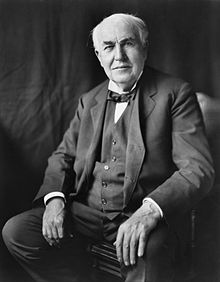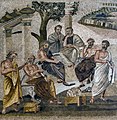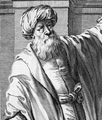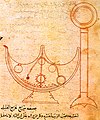Portal:History of science
The History of Science Portal
The history of science covers the development of science from ancient times to the present. It encompasses all three major branches of science: natural, social, and formal. Protoscience, early sciences, and natural philosophies such as alchemy and astrology during the Bronze Age, Iron Age, classical antiquity, and the Middle Ages declined during the early modern period after the establishment of formal disciplines of science in the Age of Enlightenment.
Science's earliest roots can be traced to Ancient Egypt and Mesopotamia around 3000 to 1200 BCE. These civilizations' contributions to mathematics, astronomy, and medicine influenced later Greek natural philosophy of classical antiquity, wherein formal attempts were made to provide explanations of events in the physical world based on natural causes. After the fall of the Western Roman Empire, knowledge of Greek conceptions of the world deteriorated in Latin-speaking Western Europe during the early centuries (400 to 1000 CE) of the Middle Ages, but continued to thrive in the Greek-speaking Byzantine Empire. Aided by translations of Greek texts, the Hellenistic worldview was preserved and absorbed into the Arabic-speaking Muslim world during the Islamic Golden Age. The recovery and assimilation of Greek works and Islamic inquiries into Western Europe from the 10th to 13th century revived the learning of natural philosophy in the West. Traditions of early science were also developed in ancient India and separately in ancient China, the Chinese model having influenced Vietnam, Korea and Japan before Western exploration. Among the Pre-Columbian peoples of Mesoamerica, the Zapotec civilization established their first known traditions of astronomy and mathematics for producing calendars, followed by other civilizations such as the Maya.
Natural philosophy was transformed during the Scientific Revolution in 16th- to 17th-century Europe, as new ideas and discoveries departed from previous Greek conceptions and traditions. The New Science that emerged was more mechanistic in its worldview, more integrated with mathematics, and more reliable and open as its knowledge was based on a newly defined scientific method. More "revolutions" in subsequent centuries soon followed. The chemical revolution of the 18th century, for instance, introduced new quantitative methods and measurements for chemistry. In the 19th century, new perspectives regarding the conservation of energy, age of Earth, and evolution came into focus. And in the 20th century, new discoveries in genetics and physics laid the foundations for new sub disciplines such as molecular biology and particle physics. Moreover, industrial and military concerns as well as the increasing complexity of new research endeavors ushered in the era of "big science," particularly after World War II. (Full article...)
Selected article -
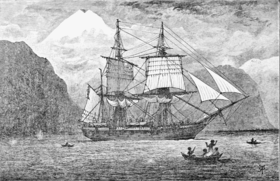
The Voyage of the Beagle is the title most commonly given to the book written by Charles Darwin and published in 1839 as his Journal and Remarks, bringing him considerable fame and respect. This was the third volume of The Narrative of the Voyages of H.M. Ships Adventure and Beagle, the other volumes of which were written or edited by the commanders of the ships. Journal and Remarks covers Darwin's part in the second survey expedition of the ship HMS Beagle. Due to the popularity of Darwin's account, the publisher reissued it later in 1839 as Darwin's Journal of Researches, and the revised second edition published in 1845 used this title. A republication of the book in 1905 introduced the title The Voyage of the "Beagle", by which it is now best known.
Beagle sailed from Plymouth Sound on 27 December 1831 under the command of Captain Robert FitzRoy. While the expedition was originally planned to last two years, it lasted almost five—Beagle did not return until 2 October 1836. Darwin spent most of this time exploring on land (three years and three months on land; 18 months at sea). The book is a vivid travel memoir as well as a detailed scientific field journal covering biology, geology, and anthropology that demonstrates Darwin's keen powers of observation, written at a time when Western Europeans were exploring and charting the whole world. Although Darwin revisited some areas during the expedition, for clarity the chapters of the book are ordered by reference to places and locations rather than by date. (Full article...)
Selected image

The Flammarion woodcut is an enigmatic woodcut by an unknown artist. It is referred to as the "Flammarion woodcut" because its first documented appearance is in page 163 of Camille Flammarion's L'atmosphère: météorologie populaire ("The Atmosphere: Popular Meteorology," Paris, 1888).
The woodcut depicts a man, dressed as a medieval pilgrim and carrying a pilgrim's staff, peering through the sky as if it were a curtain to look at the inner workings of the universe. One of the elements of the cosmic machinery bears a strong resemblance to traditional pictorial representations of the "wheel in the middle of a wheel" described in the visions of the prophet Ezekiel (see Merkabah). The caption in Flammarion's book translates as "A missionary of the Middle Ages tells that he had found the point where the sky and the Earth touched..." The image accompanies a text which reads, in part, "What, then, is this blue sky, which certainly does exist, and which veils from us the stars during the day?" The woodcut is often described as being medieval due to its visual style, its fanciful vision of the world, and to what appears to be a depiction of a flat Earth.
Did you know
...that the word scientist was coined in 1833 by philosopher and historian of science William Whewell?
...that biogeography has its roots in investigations of the story of Noah's Ark?
...that the idea of the "Scientific Revolution" dates only to 1939, with the work of Alexandre Koyré?
Selected Biography -
Thomas Alva Edison (February 11, 1847 – October 18, 1931) was an American inventor and businessman. He developed many devices in fields such as electric power generation, mass communication, sound recording, and motion pictures. These inventions, which include the phonograph, the motion picture camera, and early versions of the electric light bulb, have had a widespread impact on the modern industrialized world. He was one of the first inventors to apply the principles of organized science and teamwork to the process of invention, working with many researchers and employees. He established the first industrial research laboratory.
Edison was raised in the American Midwest. Early in his career he worked as a telegraph operator, which inspired some of his earliest inventions. In 1876, he established his first laboratory facility in Menlo Park, New Jersey, where many of his early inventions were developed. He later established a botanical laboratory in Fort Myers, Florida, in collaboration with businessmen Henry Ford and Harvey S. Firestone, and a laboratory in West Orange, New Jersey, that featured the world's first film studio, the Black Maria. With 1,093 US patents in his name, as well as patents in other countries, Edison is regarded as the most prolific inventor in American history. Edison married twice and fathered six children. He died in 1931 due to complications from diabetes. (Full article...)
Selected anniversaries
- 1500 - Birth of Cardinal Rodolfo Pio da Carpi, Italian humanist (d. 1564)
- 1632 - Galileo's Dialogue Concerning the Two Chief World Systems is published
- 1731 - Death of Frederik Ruysch, Dutch physician and anatomist (b. 1638)
- 1796 - Birth of Lambert Adolphe Jacques Quetelet, Belgian mathematician (d. 1874)
- 1817 - Birth of Carl Wilhelm Borchardt, German mathematician (d. 1880)
- 1824 - Birth of Pierre Janssen, French astronomer (d. 1907)
- 1849 - Birth of Nikolay Yakovlevich Sonin, Russian mathematician (d. 1915)
- 1857 - Birth of Heinrich Hertz, German physicist (d. 1894)
- 1875 - Death of Sir Charles Lyell, Scottish geologist (b. 1797)
- 1878 - Birth of Walter Ritz, Swiss physicist (d. 1909)
- 1879 - Birth of Johannes Nicolaus Brønsted, Danish physical chemist (d. 1947)
- 1880 - Birth of Frigyes Riesz, Hungarian mathematician (d. 1956)
- 1902 - Birth of Fritz Strassmann, German physicist (d. 1980)
- 1962 - Birth of Steve Irwin, Australian herpetologist (d. 2006)
Related portals
Topics
General images
Subcategories
Things you can do
Help out by participating in the History of Science Wikiproject (which also coordinates the histories of medicine, technology and philosophy of science) or join the discussion.
Associated Wikimedia
The following Wikimedia Foundation sister projects provide more on this subject:
-
Commons
Free media repository -
Wikibooks
Free textbooks and manuals -
Wikidata
Free knowledge base -
Wikinews
Free-content news -
Wikiquote
Collection of quotations -
Wikisource
Free-content library -
Wikiversity
Free learning tools -
Wiktionary
Dictionary and thesaurus

